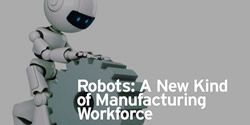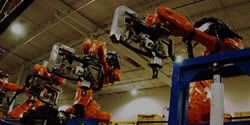The Rise of the Robots - So What?
The article will show how a 'local for local' production model - the strategy of manufacturing goods in proximity to their intended customers to promote regional self-sufficiency - can become a reality thanks to digital manufacturing.
3+2 Vs. 5-axis: What's the Difference?
Adding two axes to the conventional three axes does technically create a machine with five axes, but this 3+2 mechanism does not exactly equal a 5-Axis machine.
The Impact of Robotics in Fluid Dispense Applications in Manufacturing
Because dispense applications are so important in the manufacturing industry, companies are now looking for ways to improve the dispense accuracy and quality by investing in the latest in dispensing technology by way of semi-automated robot dispensing technologies.
What Do Robotics Mean for the Cutting Tools Industry
Friend or foe? Helper or fiend? Here's what robotics really mean for the cutting tools industry and what are the pitfalls to watch out for.
Positioning Accuracy on the Gripper of a Robot Arm
For the grinding machine producer Strausak, the robot manufacturer Stäubli and the encoder supplier HEIDENHAIN, the insertion of cylindrical tools into tool holders with a robot arm was a real challenge-and therefore a task made to measure.
Robots in Manufacturing Applications
Standard robot models are now mass-produced, making them more available to meet the ever-increasing demand. These robots are more straightforward, and more conducive to plug and play installation.
Robots: A New Kind of Manufacturing Workforce
Improving the effectiveness of small and medium manufacturers could help stimulate the economy and drive job creation. Adding robotic employees to the manufacturing mix might just make manufacturers in the United States more competitive with their counterparts in Asia.
This Factory Robot Learns a New Job Overnight
MIT Technology Review: Fanuc’s robot uses a technique known as deep reinforcement learning to train itself, over time, how to learn a new task. It tries picking up objects while capturing video footage of the process. Each time it succeeds or fails, it remembers how the object looked, knowledge that is used to refine a deep learning model, or a large neural network, that controls its action. Deep learning has proved to be a powerful approach in pattern recognition over the past few years.
“After eight hours or so it gets to 90 percent accuracy or above, which is almost the same as if an expert were to program it,” explains Shohei Hido, chief research officer at Preferred Networks, a Tokyo-based company specializing in machine learning. “It works overnight; the next morning it is tuned.”... (full story)
The making of: BionicANTs
What do ants and Industry 4.0 have in common? What challenges faced the engineers when it came to developing these delicate technology platforms? Take a look behind the scenes and dive into the world of the Bionic Learning Network... (cont'd)
Four Points You Need to Consider when Thinking About Automating or Robotizing Your Operations
If your products have regular and stable characteristics, hard automation makes sense. If however each product is different, flexible automation or robotics should be favored.
Records 1 to 10 of 10
Featured Product

Elevate your manufacturing processes with data-driven insights
Join Emerson and discover how embracing a Floor to Cloud™ strategy can revolutionize your operations. This strategy integrates on-site devices and technologies with cloud analytics, providing the insights needed to enhance manufacturing efficiency, maximize workforce potential, and achieve sustainability targets. Our team of experts have a commitment to innovation and look forward to discussing your challenges to develop a customized solution.
Manufacturing and Automation - Featured Company

FAULHABER MICROMO
Since 1961, FAULHABER MICROMO has partnered with OEMs to deliver high precision, high performance, custom micro motion system solutions to markets such as medical, robotics and automation in North America. FAULHABER MICROMO's tradition of innovation started decades ago in Germany. The groundbreaking invention of the FAULHABER coreless winding started it all for a market that produces millions of motors today.
How can the FAULHABER MICROMO team help you deliver your next innovation to market first?
Learn more about MICROMO's solutions for the most demanding applications, our diverse motion products and technologies, online ordering, Engineering and R&D teams, Clean Room Assembly, Machining Center and other services at our Clearwater, FL facility at www.micromo.com.





.jpg)




